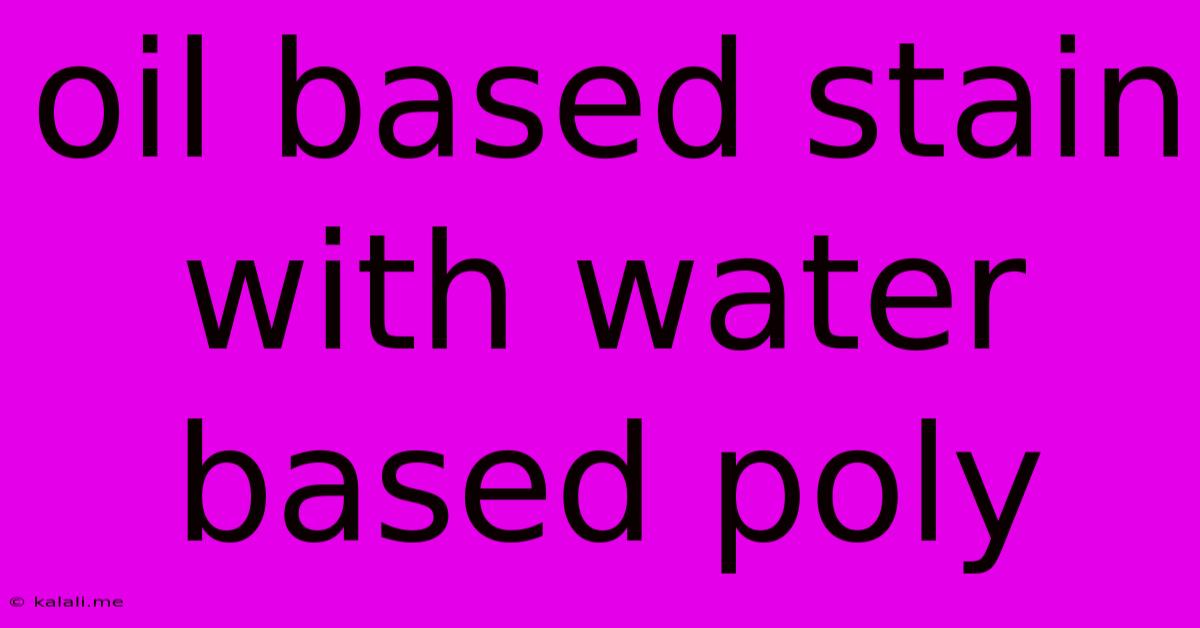Oil Based Stain With Water Based Poly
Kalali
May 25, 2025 · 3 min read

Table of Contents
Oil-Based Stain with Water-Based Poly: A Comprehensive Guide
Meta Description: Learn the best practices for combining oil-based stains with water-based polyurethane. This guide covers compatibility, preparation, application techniques, and troubleshooting tips for a professional finish.
Choosing the right finish for your woodworking project can be tricky. Many woodworkers prefer the rich, deep tones of oil-based stains, but appreciate the durability and easy cleanup of water-based polyurethane. This article will guide you through the process of successfully combining these two seemingly disparate products, achieving a beautiful and long-lasting finish. We'll cover everything from compatibility concerns to application techniques and troubleshooting common problems.
Understanding Compatibility: Oil vs. Water
The key to success lies in understanding the fundamental differences between oil-based stains and water-based polyurethanes. Oil-based stains penetrate the wood, coloring it from within, while water-based polyurethanes form a protective layer on the surface. While not directly compatible at a molecular level, they can be successfully layered with proper preparation. The biggest challenge is ensuring the stain is fully cured before applying the water-based poly. Applying water-based poly too soon can lead to the stain lifting or bleeding into the finish.
Preparing Your Wood for Staining and Finishing
Proper preparation is crucial for a flawless finish. This involves several key steps:
-
Sanding: Sand your wood to the desired smoothness. Start with coarser grit sandpaper (e.g., 120-grit) and gradually move to finer grits (e.g., 220-grit) for a smooth surface. This ensures even stain penetration and a superior final finish.
-
Cleaning: Remove all sanding dust with a tack cloth or a clean, dry rag. Dust particles trapped beneath the finish will be unsightly.
-
Stain Application: Apply your oil-based stain following the manufacturer's instructions. Allow sufficient drying time; this usually ranges from several hours to overnight, depending on the stain, wood type, and environmental conditions. Proper ventilation is essential when working with oil-based stains.
-
Checking for Dryness: Before applying the polyurethane, thoroughly check if the stain is completely dry. A simple touch test should reveal no stickiness. If the stain feels tacky, allow it to dry for a longer period.
Applying the Water-Based Polyurethane
Once the oil-based stain is completely dry, you can begin applying the water-based polyurethane.
-
Thin Coats: Apply thin, even coats of polyurethane. Thick coats are more prone to runs, drips, and other imperfections.
-
Even Application: Use a high-quality brush, roller, or spray gun to apply the polyurethane evenly. Avoid overloading the brush or roller.
-
Drying Time: Allow each coat of polyurethane to dry completely before applying the next. This typically takes several hours, depending on the polyurethane type, temperature, and humidity levels.
-
Sanding Between Coats (Optional): Lightly sand between coats with very fine-grit sandpaper (e.g., 320-grit or higher) to remove any imperfections before applying the next coat. Always remove sanding dust thoroughly before applying subsequent coats.
-
Number of Coats: Apply multiple coats (typically two to three) for optimal protection and durability.
Troubleshooting Common Problems
Even with careful preparation, you might encounter some issues.
-
Bleeding Stain: If the stain bleeds into the polyurethane, it's a sign the stain wasn't fully cured. You may need to sand back the polyurethane and let the stain dry longer before reapplying the finish.
-
Uneven Finish: This often results from uneven stain application or insufficient drying time between coats of polyurethane. Careful application and patience are key to preventing this problem.
-
Brush Marks: Use a high-quality brush and apply thin, even coats to minimize brush marks.
-
Dust Nibs: Thoroughly clean the surface before applying each coat of polyurethane to avoid dust nibs.
By following these steps and paying attention to detail, you can successfully combine oil-based stains with water-based polyurethane to create a beautiful, durable, and professional-looking finish on your woodworking projects. Remember that patience and proper preparation are key to achieving the best results.
Latest Posts
Latest Posts
-
How To Get Key Unstuck From Door
May 25, 2025
-
How To Get Rid Of Cat Spray Smell Outside
May 25, 2025
-
How Much Does 1 Litre Of Water Weight
May 25, 2025
-
Single Email Is Not Enabled For Your Organization Or Profile
May 25, 2025
-
You Must Put Some Deb Src Uris In Your Sources List
May 25, 2025
Related Post
Thank you for visiting our website which covers about Oil Based Stain With Water Based Poly . We hope the information provided has been useful to you. Feel free to contact us if you have any questions or need further assistance. See you next time and don't miss to bookmark.